Space News & Blog Articles
Webb telescope finally leaves Earth in search of light from first galaxies
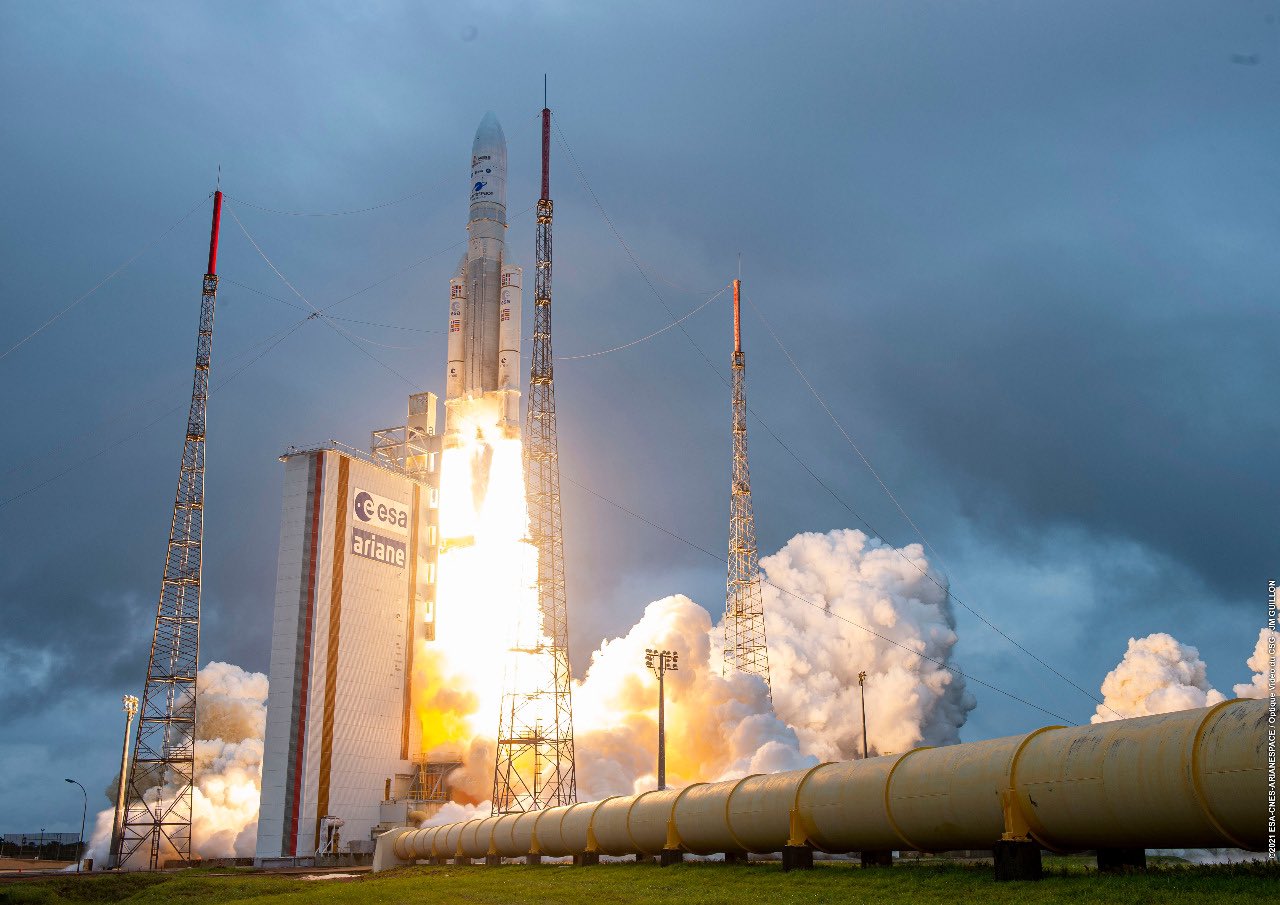 An Ariane 5 rocket, propelled by a main engine and two solid-fueled boosters, leaps off the pad at the Guiana Space Center with the James Webb Space Telescope.
An Ariane 5 rocket, propelled by a main engine and two solid-fueled boosters, leaps off the pad at the Guiana Space Center with the James Webb Space Telescope.
The James Webb Space Telescope, a NASA-led international collaboration that took nearly 30 years and $10 billion to get to the launch pad, finally left Earth with a Christmas morning rocket ride from a European spaceport in South America, setting off on a mission to hunt for the first light in the universe. That was just the easy part.
“Webb’s scientific promise is now closer than it ever has been,” said Thomas Zurbuchen, head of NASA’s science division. “We are poised on the edge of a truly exciting time of discovery, of things we’ve never before seen or imagined.”
The telescope’s launch, running more than a decade late, had NASA officials and astronomers around the world on the edge of their seats. It’s not likely they will come off the edge until the transformer telescope finishes an unprecedented sequence of deployments to prepare for scientific observations.
“The easy part is done, now the work starts,” said Massimo Stiavelli, head of the Webb mission office at the Space Telescope Science Institute in Baltimore, Maryland. The institute, located on the campus of Johns Hopkins University, is home to Webb mission control.
The three-story-tall Webb observatory was folded up like an origami to fit inside the confines of its European Ariane 5 rocket, which was selected, in part, because it has one of the largest payload volumes of any active launch vehicle.
Now that Webb is in space, the observatory will deploy and unfurl a thermal shield the size of a tennis court, swing its mirrors into place, and gradually cool down to minus 388 degrees Fahrenheit, just 40 degrees above absolute zero, a theoretical temperature limit in thermodynamics.
Then the telescope’s sensitive infrared detectors and instrument electronics have to work. Ground teams will labor to bring the telescope’s 18 primary mirror segments into focus, an effort that could take months. Around 250,000 opening and closing windows the width of a few human hairs, called microshutters, will be calibrated to cast light detector arrays onto detector arrays.
That’s just a sampling of the pioneering technology on-board Webb. If it all works, the mission will boast 100 times the observing power of the Hubble Space Telescope, the last astronomical observatory that rivaled Webb in the scale of its ambitions.
Thanks to its ability to fold up for launch, Webb’s primary mirror will span 21.3 feet (6.5 meters) across in space, making it the largest telescope ever to leave Earth. Webb’s mirror consists of 18 individual hexagonal segments, each made of beryllium and coated in gold to aid in reflectivity.
Hubble’s monolithic mirror has a diameter of about 7.9 feet (2.4 meters).
“Go Webb!”
The James Webb Space Telescope is flying free of its Ariane 5 launcher after a “perfect flight” into space, NASA says.https://t.co/LGtbJxQRAW pic.twitter.com/60yGIIamhf
— Spaceflight Now (@SpaceflightNow) December 25, 2021
Before Webb had a chance to open its eye on the universe, the observatory needed a lift into space to get above interference from Earth’s atmosphere.
An Ariane 5 rocket did the job Saturday with a successful takeoff from the Guiana Space Center in Kourou, French Guiana, located on the northeastern coast of South America.
After a smooth overnight countdown, the 180-foot-tall (54.8-meter) rocket lit its hydrogen-fueled Vulcain 2 engine at 7:20 a.m. EST (1220 GMT; 9:20 a.m. French Guiana time) Saturday. Seven seconds later, two powerful solid rocket boosters ignited their pre-packed powder propellant to catapult the Ariane 5 and Webb telescope off the launch pad.
After disappearing in a blanket of cloud cover, the rocket’s 27-minute flight with Webb went by like clockwork. The two strap-on boosters burned out and jettisoned, followed by release of the Ariane 5’s payload shroud nearly four minutes into the flight.
The core stage shut down and fell away from an upper stage, also fueled with hydrogen, to finish the work of placing Webb right where ground teams intended. An on-board camera on the upper stage showed Webb released from the rocket 27 minutes after liftoff, and the spacecraft extended its solar array a minute later to start charging batteries.
“The picture with the Earth in the background, with the dark sky and telescope leaving the upper stage — for me, that picture will be burned in my mind forever,” Zurbuchen said. “What an amazing Christmas present!”
“This was such a great moment on Christmas Day,” said Josef Aschbacher, director general of the European Space Agency, a partner with NASA on the Webb program. ESA was charged with providing the launch for Webb, and it used the workhouse Ariane 5 for the task.
“I’m very happy to say the team Europe has delivered, and I’m as happy to say we have delivered the spacecraft very precisely into orbit, in terms of altitude, speed, inclination,” Aschbacher said. “A good orbit injection allows more fuel on-board the spacecraft, and therefore, the James Webb Space Telescope can have a long life.”
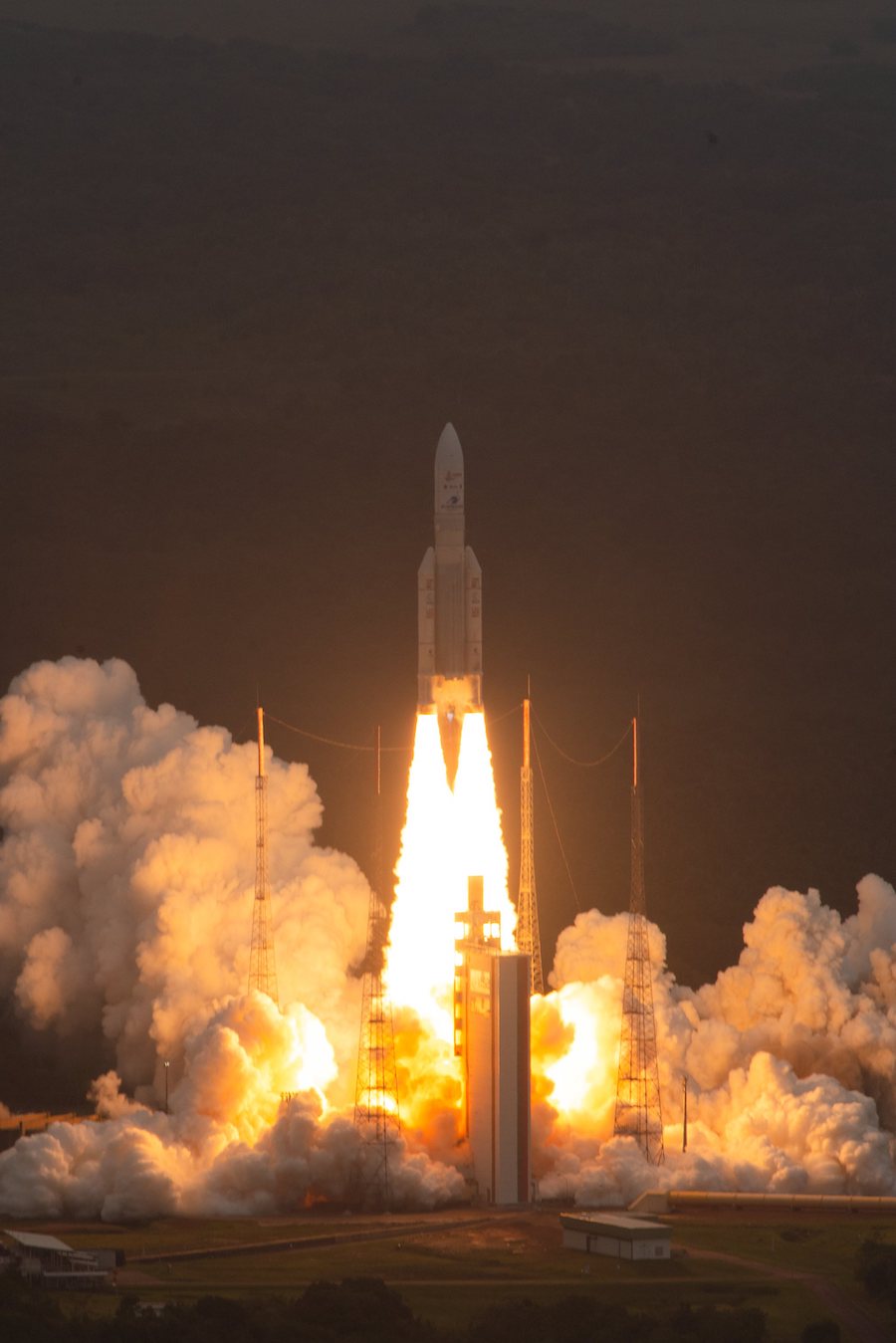 An aerial view of the Ariane 5 launch Saturday. Credit: S. Corvaja
An aerial view of the Ariane 5 launch Saturday. Credit: S. Corvaja
Webb is heading on a 29-day journey to the L2 Lagrange point, a gravitational balance location four times farther from the Earth than the moon. The observatory will slip into a halo orbit around L2, where it will point its hot spacecraft element and solar array toward the sun, and steer its frigid telescope toward deep space.
The mission is designed for at least five years of observations, and officials estimated, conservatively, that Webb could have enough propellant in its tanks to maintain its orbit for 10 years. With an on-target launch, Webb might need to burn less fuel on the journey to L2, leaving more left over for extended science operations.
The successful mission with Webb completed the 112th flight of an Ariane 5 rocket, Europe’s workhouse launcher.
“A lot of the things that we’ll do from now on are things that have never been tried on orbit before,” Stiavelli said. “They’ve been tested on the ground. Nobody has ever deployed a five-layer, tennis court-sized sunshade. Nobody has ever aligned, with exquisite accuracy, a mirror made of 18 segments.”
A rocket launch is usually the riskiest part of a space mission. That’s not the case with Webb.
“Generally speaking, the launch is on the order of 80% of the risk in a mission,” Zurbuchen said. “I would say, by our analysis and by various ways of assessing that … it may be 20% of the risk of the (Webb) mission, perhaps 30.”
Controllers at the Space Telescope Science Institute took command of Webb after it separated from the Ariane 5 launcher. They planned to calculate the spacecraft’s speed and location later Saturday, gathering data needed for a mid-course correction burn Saturday night, about 12-and-a-half hours after launch.
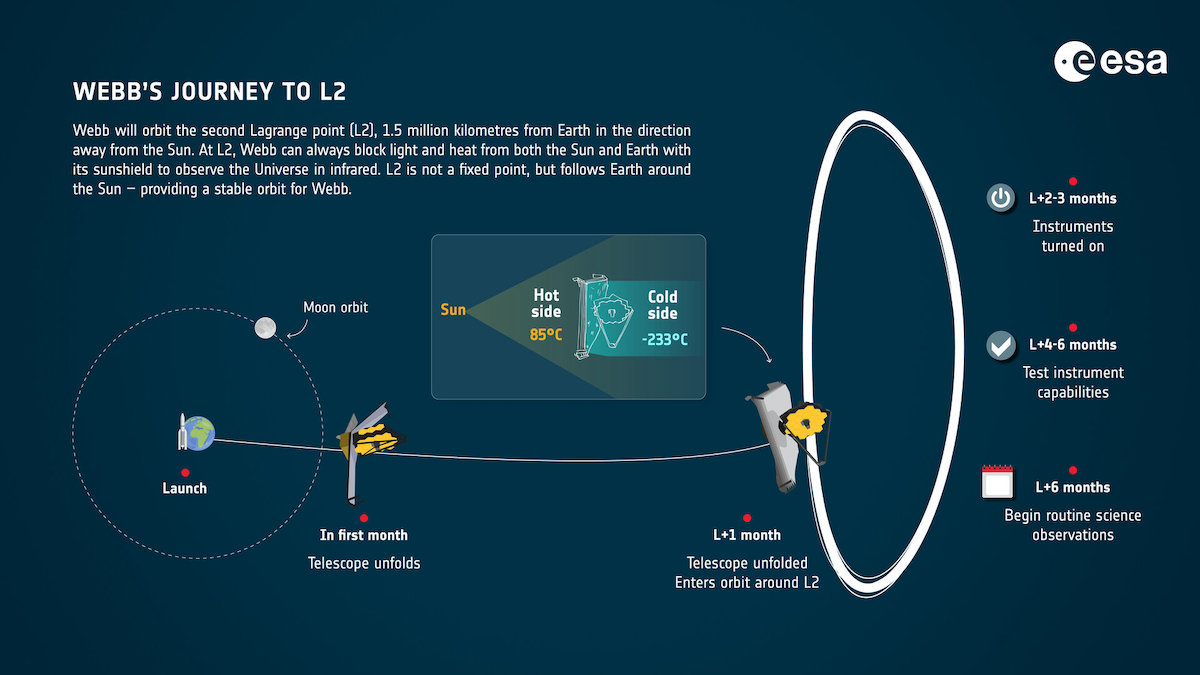 This infographic illustrates Webb’s journey to L2. Credit: ESA
This infographic illustrates Webb’s journey to L2. Credit: ESA
The Ariane 5 rocket intentionally undershot the trajectory to L2, ensuring Webb would not have to fire engines to put on the brakes in the event of an over-performing launch. A braking maneuver would expose sensitive parts of the telescope to the sun.
Webb’s first rocket burn late Saturday will add a bit of speed to reach L2.
If everything goes according to plan, ground teams will command Webb to deploy its high-rate communications antenna Sunday. The observatory will begin the process of opening its sunshield as soon as Tuesday, when two pallets containing the rolled up thermal barrier will fold down ahead of and behind the telescope’s mirror.
Then a tower holding the primary mirror structure will extend to make room for the sunshield to open up, ultimately reaching a size of 69.5 feet by 46.5 feet (21.2 meters by 14.2 meters) to permanently shade the telescope.
It will take several days to unroll the five-layer sunshield, then tension the material with a system of pulleys and cables. The outermost layer, which faces the sun, is two-thousandths of an inch (0.05 millimeters) thick. The other four membranes are half that thickness.
If the sun shield tears or snags, as it did during ground testing, it could doom the Webb mission.
The next step, planned in early January, will be the folding two wings into place to give Webb’s primary mirror it’s full size. Six of the 18 mirror segments are fastened onto wings and folded back for launch, like the wings of an fighter jet on an aircraft carrier.
With the sunshield out, Webb’s telescope element and instruments, starved of sunlight, will begin cooling down to their operating temperature. Webb is scheduled to reach its operating orbit around L2 around 29 days after launch.
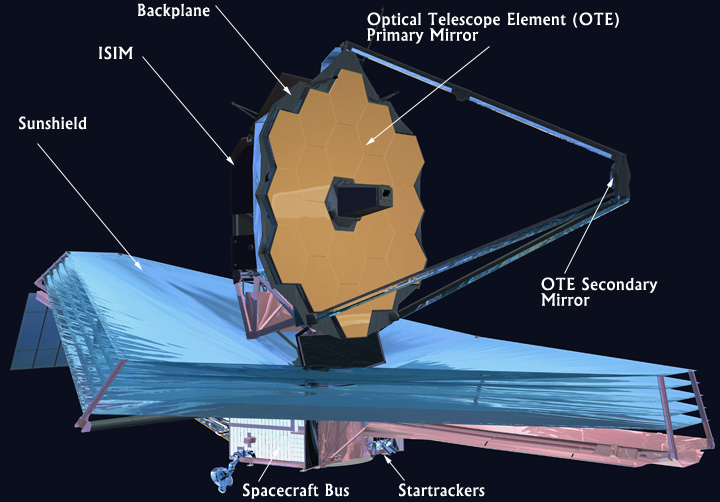 This illustration shows the major elements of the James Webb Space Telescope. The Integrated Science Instrument Module, or ISIM, contains the mission’s four science instruments. Credit: NASA
This illustration shows the major elements of the James Webb Space Telescope. The Integrated Science Instrument Module, or ISIM, contains the mission’s four science instruments. Credit: NASA
Controllers will switch on each of the instruments for commissioning, and use actuators to gently, and very slowly, nudge the telescope into alignment, allowing the individual segments to behave like a giant single mirror. That will allow scientists to check the telescope’s focus before beginning the operational science mission around six months from now, when NASA and its international partners plan to publicly release the first pictures from Webb.
The instruments have been bolted inside Webb’s Integrated Science Instrument Module, or ISIM, for more than seven years as the telescope moved around the country, and then between continents, on the road to launch.
The Near-Infrared Spectrometer, or NIRSpec, and Mid-Infrared Instrument, or MIRI, payloads come from Europe. Webb’s Near-Infrared Camera, or NIRCam, was built in the United States, and the observatory’s Fine Guidance Sensor and Near-Infrared Imager and Slitless Spectrograph are from Canada.
They’re all designed to be sensitive to faint light, or heat energy, from cosmic sources, whereas Hubble sees the universe in visible and ultraviolet wavelengths.
The mission will look back more than 13.5 billion years in time to see the faint infrared light from the first galaxies, revealing a previously unseen era of cosmic history that shaped the universe of today. It’s a cosmic time machine, capable of seeing galaxies and stars as they were as few as 100 million years after the Big Bang, the unimaginably violent genesis of the universe.
“This telescope is so powerful that if you were a bumble bee 240,000 miles away, which is the distance between the Earth and the moon, we will be able to see you,” said John Mather, the mission’s senior project scientist at NASA’s Goddard Space Flight Center in Maryland.
“So what are we going to do with this great telescope? We’re going to look at everything there is in the universe that we can see.”
That runs the gamut from the most distant galaxies in the cosmos, to planets, moons, asteroids, and comets in our own solar system. Webb will be able to observe everything from Mars out, seeing details undetected by every other space observatory since Galileo revolutionized astronomy with his first telescope in 1609.
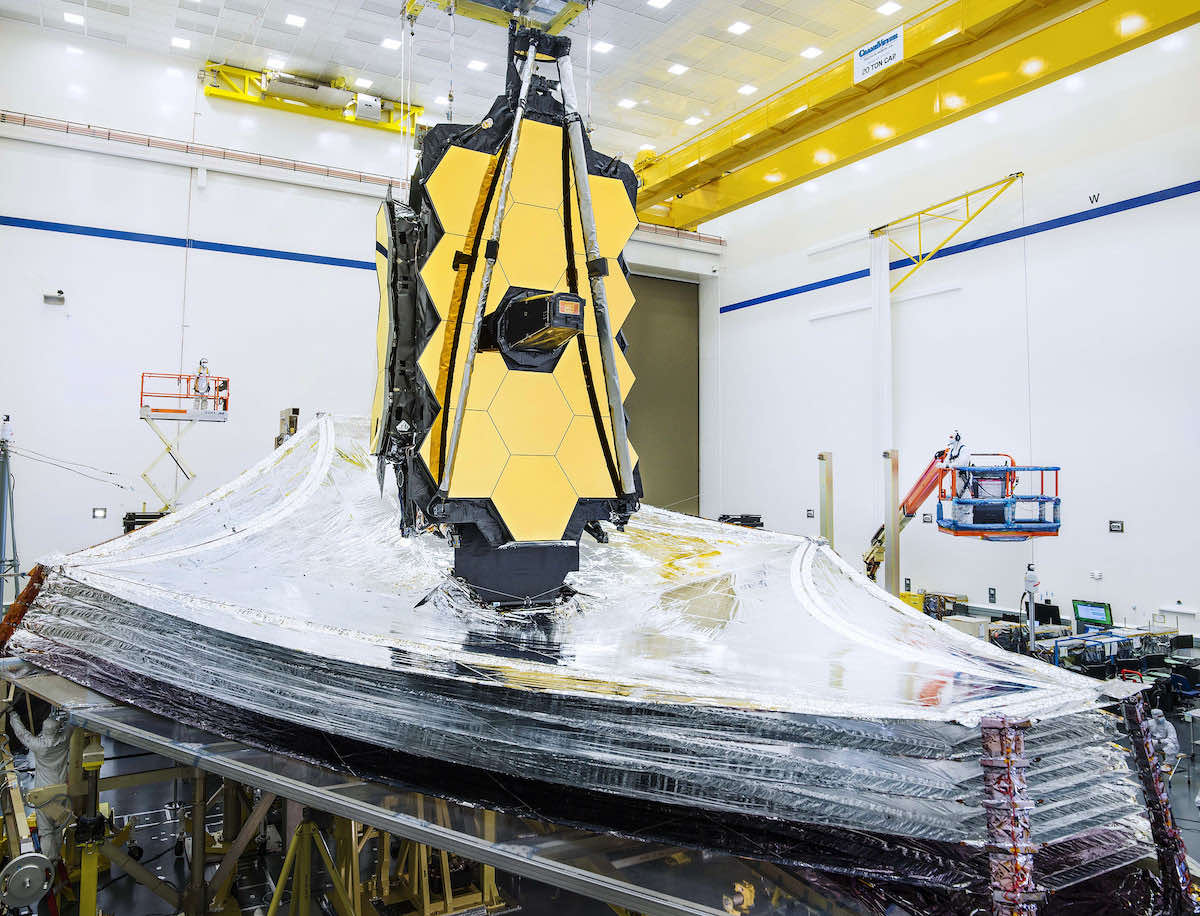 The five-layer sunshield is tensioned on the James Webb Space Telescope during ground testing at a Northrop Grumman factory in California. Credit: NASA/Chris Gunn
The five-layer sunshield is tensioned on the James Webb Space Telescope during ground testing at a Northrop Grumman factory in California. Credit: NASA/Chris Gunn
“We want to know how did we get here,” said Mather, winner of the Nobel Prize in Physics in 2006. “The Big Bang, how did that work? So we’ll look. We have ideas, we have predictions, but we don’t honestly know.”
“This is a once in a generation event,” said Pam Melroy, NASA’s deputy administrator and a former space shuttle commander. “NASA continues to push the boundaries of what’s possible, and this is such an exciting moment. For centuries, people have looked up at sky and dreamed of trying to understand the big questions. What was the start of the universe? And is there life out there beyond Earth?”
“Webb is going take the blinders off and show us the formation of the universe,” Melroy said. “This telescope represents the kind of public good for science and exploration for which our space program was established.”
The Webb mission launched with 344 single-point failures, components that don’t have a backup. About 80% of them associated with the deployment steps, said Mike Menzel, Webb’s mission systems engineer at NASA’s Goddard Space Flight Center in Maryland.
They have to work properly for Webb to do its mission.
“Landing on Mars takes roughly a third of the single-point failures than deploying the telescope fully,” Zurbuchen said. “So it really is a level of complexity that’s over and above.”
“All of these single-point failures, all of these deployment mechanisms, all of the things the have to go right to make a telescope, there’s no halfway stage,” said Mark McCaughrean, a senior science advisor at ESA and an interdisciplinary scientist with observing time on Webb in its first year of operations.
“If the sunshield only half-deploys, the telescope never gets cold, the instruments won’t turn on,” McCaughrean said. “So that’s the nerve-wracking time — that first month — and after that the five months of cool down and commissioning, and then we can start doing the science.
“There’s never 100% certainty on anything like this,” McCaughrean said before the launch. “And if it fails, I think it would be an absolute catastrophe for astronomy, for space science. There’s been a lot of talk about this mission for many years, and if it does fail somewhere along the way, there will be a reckoning.
“But that’s why we feel so much pressure to have done the right job before we launched it,” he said.
Email the author.
Follow Stephen Clark on Twitter: @StephenClark1.
When you subscribe to the SpaceZE News Feed, we will send you an e-mail when there are new updates on the site so you wouldn't miss them.

